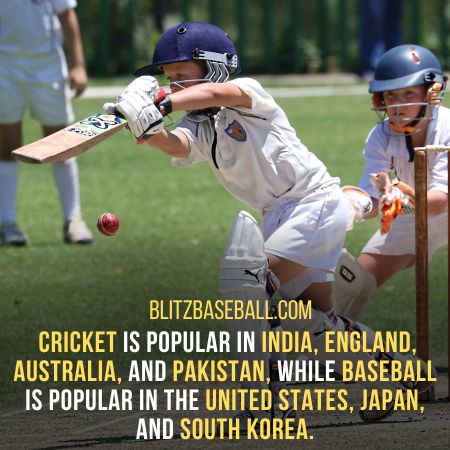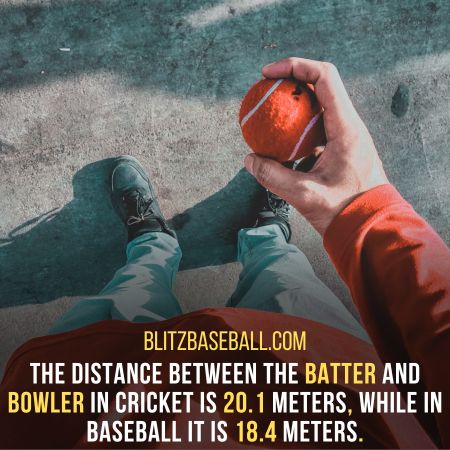Cricket and baseball are popular bat and ball games that have captivated audiences worldwide. While both sports share similarities in terms of rules and equipment, they also have distinct characteristics that set them apart.
This article aims to provide a comprehensive comparison and analysis of cricket vs baseball, highlighting their differences and similarities.
One notable difference between the two sports is the field shape. Cricket is typically played on an oval-shaped field, while baseball is played on a diamond-shaped field.
Furthermore, the distance between the batter and the bowler/pitcher varies significantly in both sports. In cricket, the bowler delivers the ball from a distance of 22 yards, while in baseball, the pitcher throws the ball from a distance of 60 feet and 6 inches.
The composition of bats and balls also differs in cricket and baseball. Cricket bats are usually made of willow wood, while baseball bats are made of solid wood or aluminum.
Additionally, cricket balls are made of cork and thread coated in red leather, whereas baseballs have a core made of cork, rubber, or a combination.
Other aspects that distinguish these sports include the number of players, innings and overs, major tournaments, and scoring systems. Cricket matches can have one or two innings, while baseball games consist of nine innings.
Moreover, cricket has various formats such as Test cricket, One day cricket, and T-20 cricket, while baseball games are usually nine innings long.
In conclusion, cricket and baseball are both fascinating bat and ball games that have enthralled fans for generations.
Although they share some similarities, their differences in field shape, the distance between batter and bowler/pitcher, bats and balls, number of players, innings and overs, major tournaments, and scoring systems make them unique in their own right.
By exploring and understanding these differences, one can gain a deeper appreciation for the intricacies of these beloved sports.
Key Takeaways
- Cricket and baseball are popular bat and ball games, but they are popular in different parts of the world. Cricket is popular in India and countries like England, Australia, and Pakistan, while baseball is popular in the United States, Japan, and South Korea.
- The field shape and distance between the batter and bowler/pitcher differ in cricket and baseball. Cricket fields are mostly rounded or elliptical, while baseball fields are V-shaped. The distance between the batter and bowler in cricket is 20.1 meters, while in baseball it is 18.4 meters.
- The equipment used in cricket and baseball also differs. Cricket bats have a flat hardwood bottom and a spherical handle, while baseball bats have a tapering handle ending in a knob. The balls used in cricket are made of cork and thread coated in red leather, while baseball balls have a core made of cork, rubber, or a combination.
- The rules and formats of the games also vary. Cricket matches can have one or two innings per side, while baseball games have nine innings. Cricket has different formats like Test Match, One day, and T-20, while baseball games are usually nine innings long.
Field Shape: Cricket Vs Baseball
The field shape is a distinguishing characteristic between cricket and baseball, with cricket fields typically being rounded or elliptical in shape, while baseball fields have a V-shaped layout.
The rounded or elliptical shape of cricket fields allows for more flexible placement of fielders, accommodating the various angles at which the ball may be hit. This shape also provides a more balanced playing field, as it prevents any particular side from having an advantage.
On the other hand, the V-shaped layout of baseball fields creates a defined playing area, with the bases forming the apex of the V.
This layout allows for clear base paths and a specific area for fielders to cover. It also facilitates the strategic positioning of fielders and ensures fair play.
The historical evolution of these field shapes in cricket and baseball reflects the unique characteristics and gameplay of each sport.

Distance between Batter and Bowler
The distance between the batter and the bowler serves as a crucial factor in determining the level of challenge and skill required in both bat and ball games.
In cricket, the distance between the batsman and the bowler is approximately 20.1 meters, while in baseball, it is slightly shorter at 18.4 meters.
This difference in distance has a significant impact on the techniques used by pitchers and bowlers in both sports.
Comparison of pitcher/bowler techniques:
- In cricket, bowlers have a longer distance to cover, allowing them to generate more speed and spin on the ball. They can use a variety of delivery techniques such as swing, seam, and spin to deceive the batsman.
- In baseball, pitchers focus on throwing the ball with accuracy and speed. They use different pitches like fastballs, curveballs, and sliders to outwit the batter.
Impact of distance on batting/bowling strategies:
- The longer distance in cricket gives batsmen more time to react and adjust their shots. They can anticipate the trajectory and spin of the ball, leading to a wider range of shot options.
- The shorter distance in baseball requires batters to have quick reflexes and make split-second decisions. They need to anticipate the speed and location of the pitch to hit the ball effectively.
Bats and Balls
In both bat and ball games, the equipment used includes specialized bats and balls.
The bat material used in cricket and baseball differs. Cricket bats have a flat hardwood bottom and a spherical handle, while baseball bats have a tapering handle ending in a knob. This difference in design allows for different hitting techniques in each sport.
The ball composition also varies between cricket and baseball. Cricket balls are made of cork and thread coated in red leather, while baseball balls have a core made of cork, rubber, or a combination. The different materials used in the construction of the balls affect their weight, bounce, and the way they are thrown or bowled.
These variations in bat material and ball composition contribute to the unique characteristics and strategies of each game.
Number of Players
Both cricket and baseball require a specific number of players on each team. In cricket, each team consists of 11 players, while baseball teams typically have 9 or 10 players.
The positions and roles of players differ in both sports. In cricket, there are batsmen, bowlers, wicket-keepers, and fielders. The batsmen aim to score runs by hitting the ball, while the bowlers try to dismiss the batsmen by bowling the ball.
The wicketkeeper is responsible for catching the ball and attempting to dismiss the batsmen. The fielders support the bowlers by stopping the ball and preventing runs.
On the other hand, in baseball, there are batters, pitchers, catchers, and fielders. The batters try to hit the ball and run to the bases, while the pitchers throw the ball to the batters.
The catchers receive the pitches from the pitchers and try to catch the batters out. The fielders support the pitchers by catching the ball and preventing runs.
Overall, both cricket and baseball have specific player positions and roles that contribute to the gameplay.

Innings and Overs
Regarding innings and overs, cricket matches can have one or two innings per side, while baseball games consist of nine innings. In cricket, each team has the opportunity to bat and bowl in one or two innings, depending on the format of the game.
This allows for strategic planning and adjustments based on the performance of the opposing team.
On the other hand, baseball games are divided into nine innings, with each team having the chance to bat and field. The number of innings in baseball provides a structured framework for the game and allows for equal opportunities for both teams to display their skills.
In cricket, the concept of overs is used to measure the number of balls bowled by a bowler. An over consists of six legal deliveries, and the number of overs in a match can vary depending on the format.
This allows teams to strategize their bowling rotations and manage the workload of their bowlers effectively.
In baseball, the focus is on pitching techniques rather than overs. The pitcher throws the ball to the batter with the aim of striking them out or inducing a hit. The number of pitches thrown by a pitcher is not limited, but their performance and stamina play a crucial role in the game.
Overall, the difference in innings and overs between cricket and baseball adds unique strategic elements to each game, highlighting the importance of planning and execution in both sports.
In Cricket:
- One or two innings per side
- Strategic planning based on the opposing team’s performance
- Overs used to measure the number of balls bowled
In Baseball:
- Consists of nine innings
- Structured framework for the game
- Focus on pitching techniques rather than overs.
Major Tournaments
Innings and overs are important aspects of both cricket and baseball, determining the length and structure of the games. Now let’s shift our focus to the major tournaments in these bat and ball games.
Major tournaments in cricket include the ICC One Day Cricket World Cup and the Indian Premier League (IPL), while baseball has the Major League Baseball World Series.
These tournaments hold significant cultural significance in their respective regions and have a massive fanbase and viewership.
Cricket, with its global reach, is particularly popular in England, India, Australia, and Pakistan. On the other hand, baseball has a strong following in the United States, Japan, and South Korea.
The tournaments in both sports attract a large number of spectators and generate immense excitement and competition among the participating teams.

Scoring System
The scoring system in cricket and baseball differs in terms of the methods used to accumulate runs. In cricket, runs are scored by the batsmen running between the wickets or by hitting the ball past the boundary rope.
The scoring system involves running between wickets, with each completed run earning one point. Additionally, hitting the ball past the boundary without the ball touching the ground results in four runs, while hitting it over the boundary on the full earns six runs.
On the other hand, in baseball, runs are scored by the batters hitting the ball and running counterclockwise around the bases.
The team with the highest score at the end of the game wins. The scoring system in baseball involves reaching and touching each base, with each completed circuit resulting in a run.
The importance of protective gear is crucial in both cricket and baseball to ensure the safety of the players. In cricket, helmets are worn by batsmen and wicket-keepers to protect against head injuries, while in baseball, helmets are worn by batters and catchers for the same purpose.
Overall, while both sports involve scoring runs, the methods and rules of the scoring system differ between cricket and baseball.
Frequently Asked Questions
What are the different types of pitches/balls used in cricket and baseball?
In cricket, different types of spin balls include off-spin, leg-spin, and googly, which are bowled by varying the wrist position and finger movement. In baseball, pitching techniques include fastballs, curveballs, sliders, change-ups, and knuckleballs, each with its own unique movement and speed.
How does the scoring system differ between cricket and baseball?
The scoring system in cricket and baseball differs in several ways. In cricket, runs are scored by running between wickets and hitting the ball past the boundary rope, while in baseball, runs are scored by running around the bases or hitting the ball beyond the fielding area.
What are the similarities and differences in the protective gear used in cricket and baseball?
A comparison of safety equipment in cricket and baseball reveals several differences. Cricket players wear helmets, leg pads, gloves, chest protectors, and abdominal guards. In contrast, baseball players use helmets, shin guards, chest protectors, and catcher’s gear.
How do the playing seasons of cricket and baseball differ?
The playing seasons of cricket and baseball differ in terms of duration and timing. Cricket seasons typically run from April to September, while professional baseball seasons in the United States span from March through October.
What are the key differences in the field layout and dimensions of cricket and baseball?
The key differences in the field layout and dimensions of cricket and baseball lie in the shape of the field and the distance between the pitcher/bowler and the batter, as well as the variations in pitch types used in each sport.
Conclusion
In conclusion, cricket and baseball are two popular bat and ball games with distinct characteristics. They differ in terms of field shape, the distance between batter and bowler/pitcher, bats and balls, number of players, innings and overs, and major tournaments.
Cricket is more popular in certain countries while baseball has a stronger following in others. Both sports have their own unique rules and equipment, making them distinct from each other.
Despite these differences, both games revolve around scoring runs and have captivated fans around the world.
